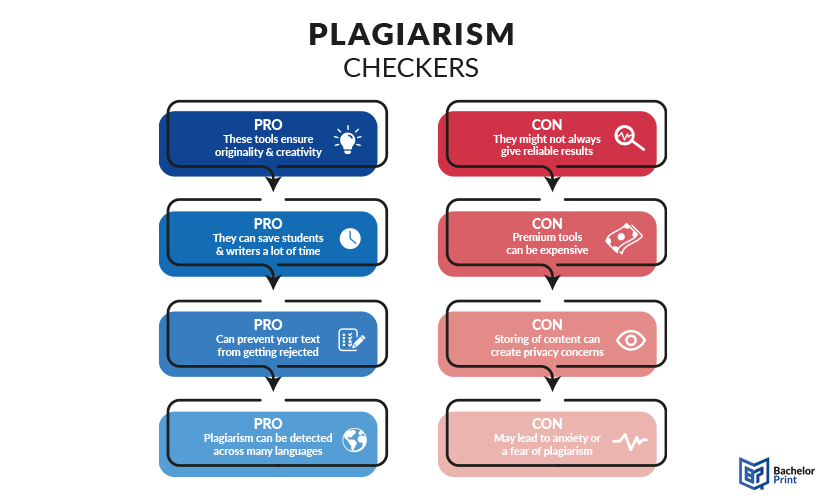
Plagiarism is an extremely concerning issue in higher education all around the globe. Nowadays, information is easily accessible, so students and publishers have to ensure originality and professional integrity in their written work. Plagiarism checkers not only help detect unintentional copying, but also promote ethical writing practices. In this article, we’ll dive into the differences and benefits of the best plagiarism checkers for students.
Definition: Plagiarism checkers
A plagiarism checker — also similarity or plagiarism detector — is a digital tool or software application that is designed to identify instances of copied, closely paraphrased text, or other types of plagiarism within a document. It compares text against a giant database of sources, including academic papers, websites, journals, and previously submitted work. They’re especially useful for longer, important documents like a thesis for a master’s or bachelor’s degree.
How do plagiarism checkers work?
Plagiarism tools use algorithms that analyze sentence structure, word choice, and phrasing to detect similarities and provide a similarity report when compared with a vast database of text. Many checkers highlight the matched content and link to the original sources to help users pinpoint where proper citations are needed.
Differences
While all plagiarism detectors share the goal of detecting duplicated content, there are differences when it comes to accuracy and capability. Here are the primary factors that set them apart.



Database size
Not all plagiarism detectors share the same database, which can result in substantial variations in outcomes. Typically, free or entry-level plagiarism checkers have limited databases that rely solely on publicly accessible online content. This limitation can result in missed matches, especially when dealing with subscription-based content or archived sources. Tin contrast, premium plagiarism detectors have more extensive databases, which improve their ability to find matches.
Types
There are different types of plagiarism checkers — code, cross-language, CMS-based, AI-powered, web-search, and academic plagiarism checkers — to choose from. While some focus on their specific databases, others scan entire search engines. Each type serves a distinct purpose: for example, code checkers identify reused logic in computer science classes as every developer has a coding style, while cross-language tools can detect translated plagiarism from multilanguage sources. Some academic checkers are integrated into an LMS (Learning Management System) and may access privately owned research databases, whereas AI-powered tools analyze sentence structure and are generally meant to catch more subtle forms of rewording.
Scanning quality
Many basic checkers can only identify precise similarities, meaning word-to-word matches. These tools may fail to identify paraphrased content or missing citations. Quality plagiarism checkers use techniques like fingerprinting or vector mapping to detect non-exact matches between paraphrased and altered material. Here, the software examines pieces of sentences to identify structural similarities and linguistic meaning.
AI plagiarism checker
AI plagiarism detectors are modern tools that use a combination of machine learning algorithms and natural language processing (NLP) to identify copied and closely paraphrased content. While chatbots like ChatGPT, Copilot, Gemini, and Grok generate text based on trained data from various sources, their primary function is to generate text based on patterns and training data. If you use output from these systems and present it as your own, then that’s also considered plagiarism.
Sometimes — as seen with AI Overview — AI can combine sources that oppose each other or use sarcasm in their texts, resulting in misleading information. But don’t confuse these plagiarism detectors with AI detectors. Even though they use similar technologies, they serve different functions. An AI detector specifically searches for patterns and structures that might be AI-generated instead of human-written. However, this use is controversial as it might lead to wrong accusations and becomes outdated with each new and improved AI model.
Benefits & disadvantages
Plagiarism detectors serve as both a preventative measure and a tool for detecting unintended plagiarism. However, like any tool, they come with their own set of challenges.
Pros
- Plagiarism tools help detect unintentionally copied content by comparing the text against a wide database of sources, which in turn, ensures originality and creativity.
- Similarity detectors save students and publishers a lot of time. This way, large documents can be scanned within minutes and don’t have to be manually checked.
- Original work boosts credibility. Not only does it affect a writer’s professional reputation, but it also builds trust with readers and professors.
- Using a plagiarism checker prevents your text from getting rejected. Whether it’s for academic, business, or creative writing, this tool guarantees that there will be no unpleasant surprises.
- Some tools can detect plagiarism across numerous languages, which is a great bonus for multilingual writers, global researchers, and international businesses.
Cons
- Unfortunately, plagiarism detectors can flag common phrases, have limited access to paid content, or may not detect paraphrased content. So, they’re not always reliable.
- While free plagiarism checkers aren’t always reliable, high-quality ones can be expensive. Which may be a barrier for some individuals, especially students.
- Users of plagiarism checkers may become overly dependent on these tools, which can reduce critical thinking and create laziness.
- Not all plagiarism tools are safe, especially free versions, as they may store or share your content, which creates privacy and security concerns.
- Students and writers might over-edit their work due to anxiety or fear of plagiarism. This can also lead them to be less confident in their writing skills.
By the way, BachelorPrint offers a 10% printing discount when using our online plagiarism checker software.

FAQs
A plagiarism checker is a tool or software that detects copied or closely paraphrased sections in a document.
When writing longer academic works, such as a bachelor’s or master’s thesis, using a plagiarism detector tends to be useful. However, not every writer needs to check if sentence structure and citations align. You as a writer should ensure that you’re not copying someone else’s or your previous work, even without plagiarism checkers. Even AI detectors can be wrong and falsely accuse students of using AI.
How accurate plagiarism detectors are depends on the type you use. Free ones tend to be less accurate, while premium tools use a vast database, resulting in better results. However, plagiarism checkers aren’t always a 100% reliable tool and can create false positives.
